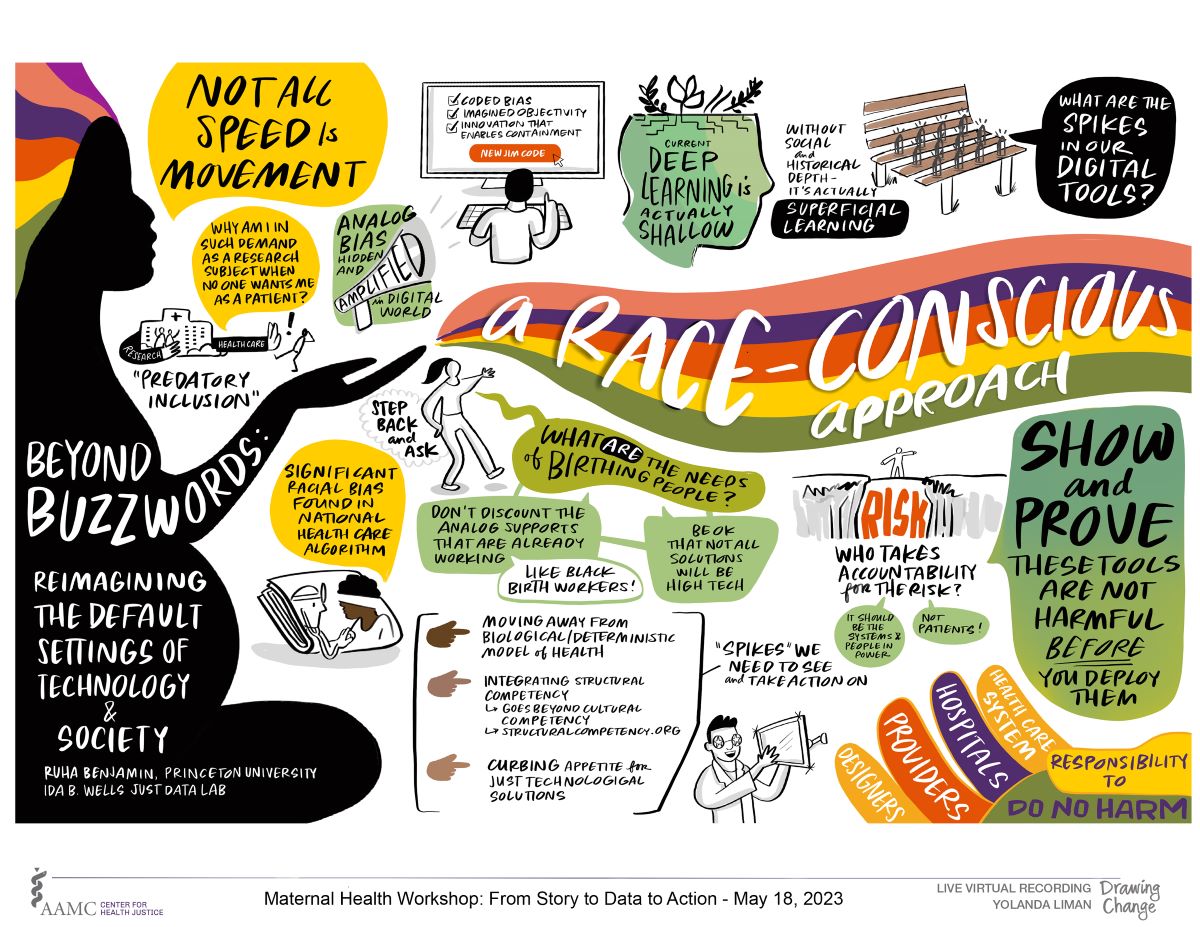
About This Graphic
This is a hand-illustrated graphic recording, created live during a keynote presentation at the Maternal Health Equity Workshop: From Story to Data to Action, May 18, 2023, which was convened by the Association of American Medical Colleges Center for Health Justice. Graphic recordings were created by Drawing Change. The effect is dynamic and there is a multicolored ribbon that gracefully swoops across the page with the words “a Race-Conscious Approach,” which are the largest words on the page. On the left-hand side in solid black silhouette is a pregnant person, seated cross-legged, with their hand outstretched reaching into the banner and whose large, natural hair is also drawn in the muted pastel colors of the ribbon. There are small spot illustrations throughout the piece and text is separated by background shading and different lettering sizes.
Beyond Buzzwords: Reimagining the Default Settings of Technology and Society
With Ruha Benjamin, Princeton University and Ida B. Wells Just Data Lab
Not All Speed Is Movement
Illustrated concept of “predatory inclusion.” There is an icon of a hospital with two arms, one labeled “research,” holding two people close to it dramatically, and the other labeled “health care,” with the health care arm pushing a patient away from the door. The patient asks, “Why am I in such demand as a research subject, when no one wants me as a patient?”
Drawing of a megaphone with this text: Analog bias: hidden and amplified in a digital world.
Race and AI
An illustration of the back of a person with short dark hair typing at a computer. The screen says:
- Coded bias
- Imagined objectivity
- Innovation that enables containment
- New JIM code highlighted in a contrasting color
Image of plants growing out of concrete, with an underground view of the roots. The roots have text that says, “Current deep learning is actually shallow. Without social and historical depth, it’s actually superficial learning.” An illustration of a park bench with hostile architecture spikes meant to keep people from lying down on it that asks, “What are the spikes in our digital tools?”
Queries
A small figure drawn in outline with a long ponytail has text behind them that reads, “Step back and ask,” and a person who asks, “What are the needs of birthing people?” Three speech bubbles connect and say:
- Don’t discount the analog supports that are already working
- Like Black birth workers!
- Be okay that not all solutions will be high tech
Image of a thick medical folder/health record with a White health provider taking the temperature of a patient with brown skin and black hair; the caption reads, “Significant racial bias found in national health care algorithm.”
Action
A chart is outlined with a thin box, with three multi-racial hands highlighting the “spikes” to take action on:
- Moving away from biological deterministic model of health
- Integrating structural competency which goes beyond cultural competency (see structuralcompetency.org); curbing appetite for just technological solutions.
Next to this chart is an illustration of a provider wearing prism glasses holding a computer monitor screen, symbolizing what we need to “see” differently.
Risks of AI
Drawing of a cliff, with a small icon figure walking a tightrope. In the chasm is the bold, red word “RISK,” followed by: who takes accountability for the risk?
- It should be the systems and people in power
- Not patients!
Next to this cliff and chasm is a huge green bubble with the main takeaway: Show and prove that these tools are not harmful before you deploy them. A stylized hand holding up a large green bubble, with fingers that are each a different color (that match the Race Conscious banner. The fingers read: health care system, hospitals, providers, designers = responsibility to do no harm.